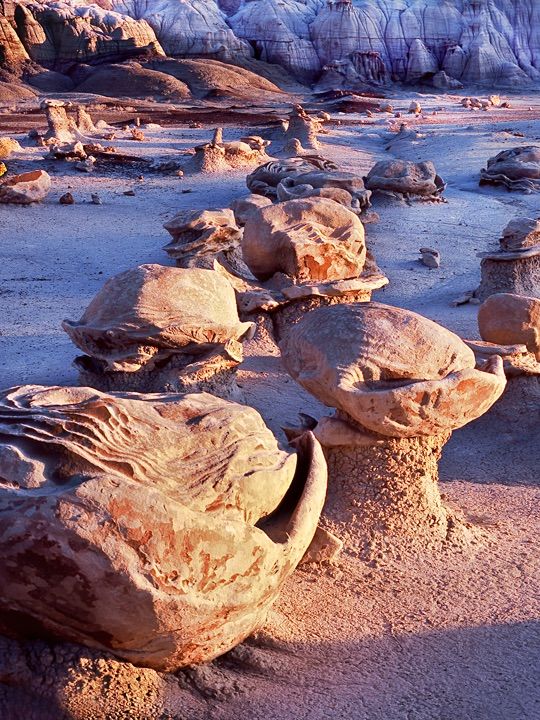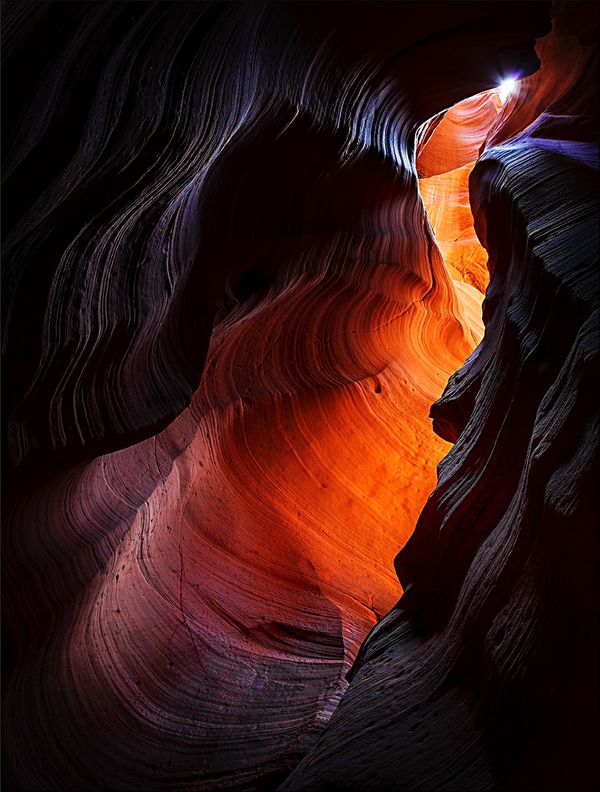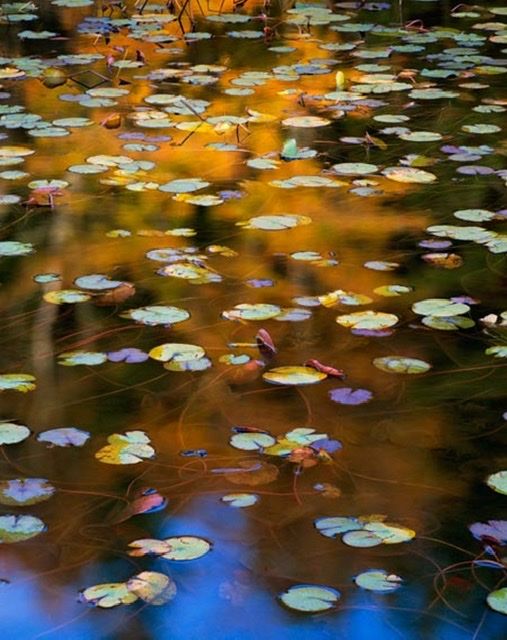Posts for: Photographer Jim
Oct 17, 2019 16:28:41 #
Bill P wrote:
Can someone please explain to me what is the point of this useless exercise in splitting already split hairs?
Participating in the discussion is keeping most of us off the streets and out of trouble.
Oct 17, 2019 15:42:20 #
Bokehen wrote:
If there isn't a horizontal plane within the landscape image, (even if the photographer wants you to believe there is or isn't) then the image is merely abstract. Also, the horizontal plane doesn't have to be a straight line and may or may not be seen by those viewing the image.. it will fool the eye into thinking there is one even if there isn't.
We may be splitting hairs here, but ... Here is one of Porter’s images. Subject matter is totally identifiable, obvious image of natural world, no horizon. Yes, the color pattern suggests abstraction, but I’d submit that it would be considered an “intimate landscape” rather than an abstract image. Admittedly, most images people consider to be a landscape contain a horizon of some form, I’m not convinced that it is required. 🙂
Oct 17, 2019 11:08:55 #
Bokehen wrote:
I've been under the assumption that a landscape shot would or should have a horizontal plane at some point in the image. even if one holds the camera vertical the image should still have a horizontal plane. if the picture is nothing more than a light house without a horizon with the horizontal plane then it would not be considered a landscape and instead could be known as a portrait.
If by horizontal plane you mean a horizon line, I’d disagree. Photographer Eliot Porter became well know for his “intimate landscapes” which often did not show either sky or a horizon line. (I.e. shots of desert walls with stripes of desert varnish).
Oct 14, 2019 13:44:05 #
Gene51 wrote:
Sign directly on the print using an archival gel p... (show quote)
I have seen that method used as well here on West Coast.
Oct 14, 2019 11:45:37 #
I sold my images on the art circuit for a number of years, as well as a few galleries. Things vary, but my experience is that the generally accepted practice is to sign the image in the margin under the mat, with an additional visible signature on the mat below the right hand lower corner of the mat window edge. The double signing allows the customer to maintain your signature on the print even if they need/choose to change the mat in the future. Signatures are expected to be hand signed and not a digital signature embedded in the print. ( I once had a gallery owner comment about that practice: “We sell art here, not posters.” 😄). I do know a few photographers who do sign directly on the print rather than the mat. One well known photographer in the Southwest uses white archival ink and signs and numbers his prints small in the lower right corner. (He is a “name” photographer whose works sell for significant prices. He can do what he wants! 😁)
Oct 13, 2019 20:34:40 #
silver wrote:
Manfroto makes an L bracket that sells for about $100.00 depending on where you buy it. This is a very solid bracket that easily supports the Nikon D850 camera. The bracket is the Manfroto Q5. IO have 3 of these for all of my cameras.
Keep in mind that this L bracket is not compatible with Arco-Swiss tripod heads. You must be using the Manfroto proprietary quick release system to make use of this bracket.
For what it’s worth, I can’t comment on other brands, as I have not used them, but I have used RRS L brackets on all of my cameras for years with total satisfaction, and have no problem recommending them as a quality product.
Sep 30, 2019 12:23:04 #
julesannb wrote:
I am new to this forum and fairly new to photography, but finally have the time to learn and enjoy photography and maybe sell some prints. I always wonder and marvel at the beauty of the images on this forum, but I am curious. Why do photographers need to edit or manipulate images to look so much more colorful and sometimes almost unworldly?
Because:
1: The results usually please me.
2: The results usually coincide with my “artistic vision” (for lack of a better term). The aesthetic that I achieve is satisfying to me from a creative standpoint.
3: Other seem to enjoy the results (at least judging from my sales).
4: I can.
Sep 28, 2019 16:54:48 #
Linda From Maine wrote:
I confess to being confounded by the attitude that... (show quote)
I so agree.
"Support of extreme post-processing in defense of creativity is no vice. And insistence on straight out of camera in pursuit of "purity" is no virtue". -Gary Boldwater- 😎
Sep 28, 2019 16:49:30 #
I shoot almost exclusively in RAW and usually do a fair amount of processing when finalizing an image, so for me, no. There are probably some people on this forum to who either intentionally avoid PP or have yet to learn PP techniques, so they do post images pretty much unaltered from the camera output. In the end, it really is of little importance, as images are best judged as presented. Good is good, bad is bad, regardless of how much or how little processing was used in its creation.
Sep 11, 2019 15:36:26 #
Cany143 gives you some good advice. Many think of the Southwest as being hot, dry desert year round, but during the winter months some areas are not at all like what they expect. Bisti is one such area, in that it’s elevation is 6000 ft +- hopefully you’ll have dry conditions allowing you good access and hiking, but do be prepared for temperatures lower than what many visitors expect.
Another after thought: many good photos can be gotten around dusk, but it may mean hiking back to the car partially in the dark. There are no obvious trails. If you have one, a handheld gps can be very helpful, (I turned tracking on when I left the car and then used the track of where I had been to help me navigate the best straight line route back to the car.). as well as a hiking headlamp. I also found trekking poles useful.
Another after thought: many good photos can be gotten around dusk, but it may mean hiking back to the car partially in the dark. There are no obvious trails. If you have one, a handheld gps can be very helpful, (I turned tracking on when I left the car and then used the track of where I had been to help me navigate the best straight line route back to the car.). as well as a hiking headlamp. I also found trekking poles useful.
Sep 11, 2019 14:41:05 #
(I’m going to assume you are planning to start at the main entry parking on county road 7290 off of NM371)
Yes, There are some good formations fairly close to the parking area worth a little exploration. However, it is really worth your while to take a trek out into the main area in order to photograph more interesting hoodoos and rock formations. Honestly the hiking is not that bad. It’s relatively flat, and although sandy, has good footing. You can reach many extremely interesting hoodoo fields (“The Egg Factory”) in about 30 to 45 minutes from the parking lot. You say you’re in relatively good health, so I don’t think you would find it as difficult as you might fear. (You can always turn around and go back if you find it too strenuous). I’m just a few months shy of 70 and found it quite doable.
Robert Hitchman, of Photograph America, has one of his newsletters dedicated to the area. It costs $8 and can be downloaded as a pdf file that you can load to your smartphone for reference. His newsletters are generally quite informative as they are written by a photographer for other photographers rather than your typical tourist. Here’s the link:
https://shop.photographamerica.com/Bisti-Wilderness-New-Mexico-p/062-pdf.htm
Yes, There are some good formations fairly close to the parking area worth a little exploration. However, it is really worth your while to take a trek out into the main area in order to photograph more interesting hoodoos and rock formations. Honestly the hiking is not that bad. It’s relatively flat, and although sandy, has good footing. You can reach many extremely interesting hoodoo fields (“The Egg Factory”) in about 30 to 45 minutes from the parking lot. You say you’re in relatively good health, so I don’t think you would find it as difficult as you might fear. (You can always turn around and go back if you find it too strenuous). I’m just a few months shy of 70 and found it quite doable.
Robert Hitchman, of Photograph America, has one of his newsletters dedicated to the area. It costs $8 and can be downloaded as a pdf file that you can load to your smartphone for reference. His newsletters are generally quite informative as they are written by a photographer for other photographers rather than your typical tourist. Here’s the link:
https://shop.photographamerica.com/Bisti-Wilderness-New-Mexico-p/062-pdf.htm

Aug 24, 2019 18:46:22 #
Linda From Maine wrote:
I ventured (momentarily) out of retirement to post... (show quote)
My God, it’s true! Once you post something to the “internets”, it never goes away! 😁
Aug 17, 2019 14:05:39 #
When we first start learning photography the majority of our time is usually spent learning to control the more technical aspects. We often concentrate on learning how to get sharp images, with accurate focus and proper exposure , and which have appropriate depth of field. Once those technical skills are mastered improvements in our images needs to shift toward a conscious attention to the more artistic elements of our compositions. Awareness of how painters manage those elements can be helpful in allowing us to go beyond just creating a technically fine image and create a photograph which has artistic merit as well. Thanks for posting.
Aug 17, 2019 13:32:01 #
rmalarz wrote:
Sue, here's a suggestion. If you are only going to be using this lens for this event, why not just rent one? If it turns out you fall in love with it, then you can consider purchasing one.
As far as purchasing a used lens, I'd only consider purchasing used equipment from Nikon, B and H, or Adorama. They are reputable.
--Bob
As far as purchasing a used lens, I'd only consider purchasing used equipment from Nikon, B and H, or Adorama. They are reputable.
--Bob
Agreed. Renting a lens can be a great way to test out a lens to see if it suits your needs, especially if you are not sure if it is a lens that you will use a lot.
In addition to the sources mentioned, if you decide to buy and want to go used, KEH.com is also a very reputable source. I’ve purchased two used lens from them over the years and have always found the quality of their equipment to exceed my expectations.
Aug 17, 2019 01:31:18 #
Vienna74 wrote:
The most frustrating posts I read here are the one... (show quote)
The difficulty with offering advice about lens choice goes beyond just knowing the subject matter a person likes to shoot, as the traditional choices may not always suit a person’s style, and may vary with their experiences. For example, I have often heard people advise using a wide angle lens in slot canyons, but I know from my own experience that a longer lens can allow zeroing in on shots high up on the canyon walls. When shooting the barns at Mormon Row in Jackson hole, I used a long lens from a distance in order to take advantage of the “compression effect” to make the Tetons appear closer and more massive.
The point is that such advice can at best, only be a very general, and possibly creatively limiting suggestion.
Ultimately the best strategy is take the lenses one is most comfortable with, and then add in whichever others your travel conditions allow. Just understand that whichever lens you leave at home will, at some point, undoubtedly be the one you wish you had with you! 😛




